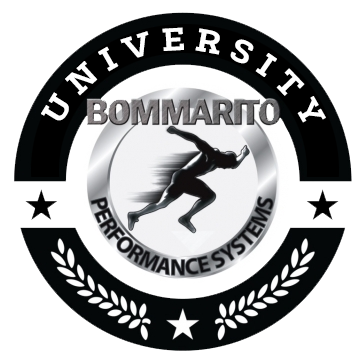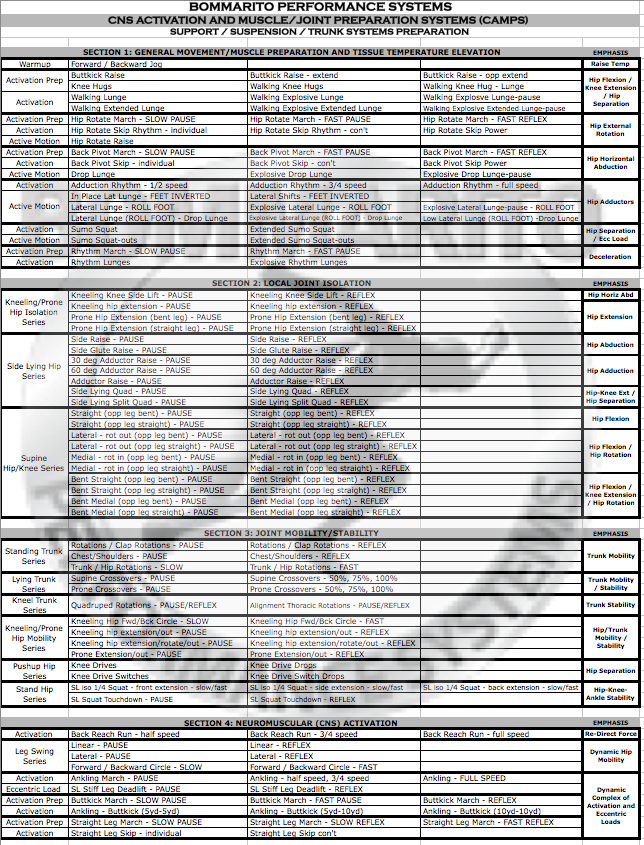Pete Bommarito, MS, CSCS, USAW, MATCS, MAT Jumpstart
When thinking about multi-directional movements, many coaches think only in terms of changing directions. While that is certainly important, there are many additional aspects to consider with regards to movement and speed patterns in “multiple directions”, even before a direction change occurs off of the pattern. For instance, an analysis of what is occurring during a highly dynamic “lateral” motion, which is a pattern that is commonly placed into speed/movement-training programs could lead to three primary options:
- LATERAL RUN (LR)
- BACK LATERAL RUN (BLR)
- BACK ANGLE LATERAL RUN (BALR)
There are numerous other primary options for movement in a multi-directional sense – such as lateral shuffle, backpedal/anglepedal, and forward multi-directional – but they are more controlled motions. Looking at a faster, more dynamic motion, including when it needs to be executed at full speed, the three primary aforementioned motions apply.
Note the motions uploaded to the Exercise Database (also featured in the 6-2-15 “Exercise of the Week.”).
Lateral Run (LR)
This is basically a full sprint motion with the line of sight perpendicular to the motion. Note that the shoulders must remain square to the line of motion. However, the “piston” action of the acceleration is very similar to a regular linear sprint motion. The exact same phases of the sprint cycle still occur:
- Residual phase – moment from the time the foot leaves the ground to the moment that the thigh begins forward motion (flexion)
- Recovery phase – moment from the initiation of thigh flexion to the end range of motion of thigh flexion
- Transitional phase – end range of motion of thigh flexion to initiation of thigh extension
- Ground preparation phase – initiation of thigh extension to ground contact
- Ground contact phase – the entire phase the foot is in contact with the ground.
Note the extreme similarities to a regular linear acceleration – the “piston action” of the legs are the exact same with two distinct differences:
- There is additional contributions of the abductors and adductors during the Recovery Phase and Ground Preparation Phase, leading the piston action across to the center of mass (COM) of the body during Recovery to slightly outside of a linear sprint position during Ground Preparation
- There is different challenges of stabilizing the foot during Ground Contact since the absorption of force and redirection of force during this phase is slightly off the edges of the feet
The contributions to motion are also the exact same as a linear sprint:
- Conscious activation of muscles
- Stretch reflex mechanisms after Ground Contact and upon Transitional Phases
- Sub-conscious reflex (Crossed-Extensor Reflex) – meaning the efficient arm action will lead to a more efficient leg piston action; in a sense, the arms lead the legs and still should be trained and coached as such – just like in linear sprinting
A lateral run motion is specific to many sports. The most obvious being a Linebacker in football, a tennis player, a soccer player – any sport which a high dynamic (or full speed) lateral motion must occur, but the line of sight must be different than the actual motion (like a Linebacker running along the line of scrimmage, but the line of sight is on the QB, not the direction of motion). However, almost every single sport uses this motion, even if it’s only a step or two (examples is basketball, volleyball, a baseball infielder, lacrosse, etc.).
Back Lateral Run (BLR)
This is essentially the exact same movement pattern as LR, with the only difference being the proprioception of the line of sight. Note that in a LR, the athlete can still view where he/she is running out of the peripherals (even if the line of sight isn’t exactly looking to the end destination of the motion). In the BLR, the head is rotated so the line of sight is exactly in the opposite direction of the motion. There is zero chance of any sight of end destination of the run. This places a much greater challenge of efficiency of the piston leg action because the proprioceptive concept of “running full speed where you are not looking”. Keep in mind that this is a trainable effect. The more comfort an athlete has in this new proprioceptive stimulus, the more efficient the overall motion can be.
A BLR is also specific to many sports. The most obvious being a defensive player in football moving away from the line of scrimmage (but sight still being in the offensive backfield on the QB or skill players being covered); a baseball outfielder tracking down a fly ball; or a defensive player in soccer covering a man but sight being on the ball. Just like LR, a BLR is still specific to many sports even if it’s only one step (again examples like basketball and volleyball).
Back Angle Lateral Run (BALR)
This follows the exact same concepts as the BLR. The only difference being that the head is rotated to a greater angle, which increases the challenge of the overall proprioceptive stimulus.
This is still specific to all the aforementioned sports. A great example being a defensive player in football that needs to move away from the line of scrimmage (LOS) with line of sight being on the QB – but the angle of moving away from the LOS isn’t always a direct perpendicular line to the LOS (as it would be with the BLR). Many times it’s on an angle – hence the Back Angle Lateral Run.
It’s interesting to note that the BLR and BARL still have the exact same motions and challenges of the lower body action as seen in the LR. The main increase of the challenge lies in the proprioceptive stimulus of maintaining efficient movement patterns with head turned 90 degrees (BLR), or greater (BALR) and no peripheral vision of end destination of the motion.
Changing Directions (COD)
All three of these motions (LR, BLR, BALR) can have two primary categories of a change of direction off of the motion:
- Change of direction to the “same side”
- Change of direction to the “opposite side”
Both of these categories are exemplified in the Exercise Database. A change of direction to the same side can be a sprint out of the LR/BLR/BALR along the same line. Note that there can be times where a LR changes into a full speed sprint on a slight angle. This category is mainly any COD that is greater than 90 degrees off of the LR/BLR/BALR. There should be no loss of speed (in advanced athlete cases, speed can actually be gained off of the COD), and it’s a “cut” off of one foot.
A change of direction to the opposite side is any COD off of a LR/BLR/BALR that is less than 90 degrees. It can be a “full turn” – like shown in the Pro Shuttle drill, or it can be at a slight angle. In this case, there must be a breaking deceleration step, slight stop, and re-acceleration. Hence, it’s a COD off of two feet. The edges of the feet and the ability to absorb force and redirect force off the edges of the feet are of primary importance. Note that the “break deceleration” step will always be on the outside edge of the foot of the inside leg; and the “stop and re-redirecting” step will always be off of the inside edge of the foot of the outside leg. Primary plyometrics and footwork drills off the edges of the feet thus become great building blocks to overall efficiency of these 3 motions and any changes of direction off of these 3 motions.
It’s also important to note that these three primary motions (LR, BLR, BALR) and all of the changes of direction need to be trained for all sports. Don’t always think in terms of training in to be exactly sport specific. Sometimes its essential to get the full training effect, as shown with the minimum of 5-yard motions demonstrated in the Exercise Database.
A great example of this is basketball players. Watching this unique sport, and the movement requirements of this sport, it’s easy to identify that these motions do occur, but almost always within a very short, confined space. Hence, there is rarely a time where a basketball player executes a LR, BLR, or BALR for 5 yards. It’s always just a step or two. However, in training this motion, sometimes it’s best to carry the motion out 5 yards. This obviously does not look like what occurs in the sport – but remember, we are training for efficiency, not just trying to recreate the sport. If you want to be more efficient at the exact motions required for basketball, play basketball. We are performance coaches, NOT sport coaches. Our job is to maximize efficiency of motion, to be able to be applied to the sport. If an athlete executes a full speed LR for 5 yards, think of what is occurring towards the end of the 5-yard motion. The body is moving at greater speeds, especially with the piston action – meaning that the muscle action and the stretch reflex mechanisms, and the challenges of absorbing and redirecting forces through the edges of the feet are now greatly intensified. This intensified “training of the muscles” will have a greater transfer to the sport, when only a step or two is required. Also, moving at greater speeds throughout the 5-yard zone will greatly increase the challenges of changing directions off of the motion (and thus the deceleration and re-acceleration components of the muscles during this COD). Again, the training effect of the muscle action during this drill will have a greater transfer to the sport because the threshold of accepting and redirecting these forces is constantly being raised throughout the training cycle.
This line of thinking of “training muscles, NOT recreating motions” is important when considering all aspects of sports performance. But it really holds great value when analyzing LR, BLR, and BALR.


